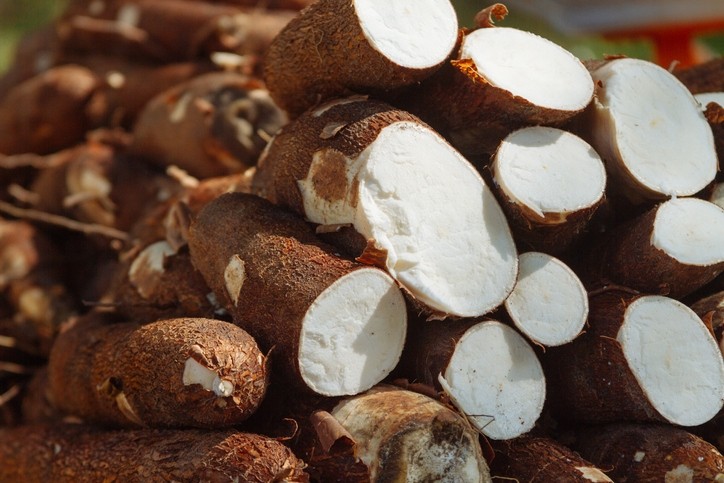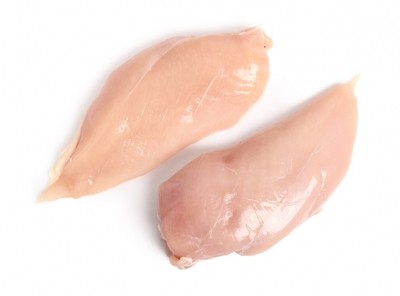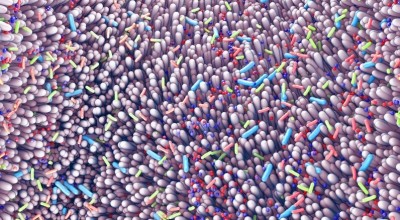Brazilian team find enzyme use aids cassava by-product inclusion in poultry feed

A team of researchers from Brazil explored the use and influence of dry residue of cassava (DRC) and carbohydrases in the diets of broiler chickens. The study was published n the Journal of Applied Poultry Research.
“The objective of this study was to evaluate the effects of dietary inclusion of DRC supplemented or not with carbohydrases on broilers performance, yield carcass and cuts, blood parameters and meat quality from 22 to 42 d of age,” the researchers said.
The researchers found that there was a change in the feed conversion ratio (FCR) when carbohydrases and DRC were included in the diets as birds receiving the diet without enzymes saw a linear increase in FCR as more DRC was included in the feed.
Addition of both the enzyme and DRC in the feed altered breast yield and an increase in the relative weight of the small intestine, they said. Adding increasing amounts of DRC also linearly reduced the relative weight of the gizzard, prompted a quadratic effect on water retention capacity and linearly lowered the b* variable level in colorimetric analysis of both breast meat and broiler feet.
Carbohydrase use influenced plasma creatinine and gamma-glutamyl transferase amounts, they said.
“It can be concluded that up to 10% of DRC can be used in broiler diets from 21 to 42 d of age when associated with carbohydrase for performance maintenance,” the researchers said.
Adding cassava, dry residue cassava
Cassava has been used as a feed ingredient in poultry diets to boost nutritional quality and lower feed costs, the researchers said. Dry residue of cassava (DRC) is a co-product generated during cassava processing.
Previously, the coproduct has been used without negatively altering performance or carcass quality, they said. It can provide an energy source in non-ruminant diets and replace a percentage of corn.
“Dry residue of cassava is a cassava co-product composed of residue of the fibrous material and the starch that was not extracted during root processing,” they said. “Dry residue of cassava contains 11% crude fiber, 27% of neutral detergent fiber (NDF), 19.5% of acid detergent fiber (ADF), 60%–70% starch, 3,519 kcal crude energy, and low levels of protein and lipids, in the natural composition.”
The high fiber level – including the amount of insoluble fiber – limits its use, the researchers said. “The DRC fibers are mainly composed of cellulose, insoluble hemicellulose and lignin which can dilute the nutrients and accelerate gastrointestinal transit,” they added.
Why use enzymes with cassava in poultry feed?
Adding exogenous enzymes to DRC could be a way to improve the use of DRC in poultry feeds, the researchers said. Enzymes like carbohydrases, including “xylanase, β-glucanase, β-mannanase, pectinase, and α-galactosidase” have been recommended for use with fibrous diets.
“Carbohydrases allow for better nutrient utilization by increasing the digestibility and maximizing the action of the endogenous enzymes on specific substrates,” they said. “Carbohydrases can also impact positively intestinal mucosa and reduce undesirable bacteria.”
Feed trial details
During the feeding trial, 950 broiler chicks received one of 10 diets for 21 days, lasting from day 21 to 42 of production, the researchers said. From day 1 to 21 of production the chicks received a pre-experimental corn and soybean meal diet with no DRC or carbohydrases.
Trial diets included DRC at 0, 2.5, 5, 7 or 10% and with or without a supplemental combination of carbohydrase enzymes including xylanase, α-amylase, and ß-glucanase, they said. Diets also contained corn, soybean meal, poultry by-product meal, soybean oil, minerals and vitamins.
Birds were checked for weight gain (WG), feed intake (FI) and feed conversion ratio (FCR) – which were calculated at day 42, they said. Blood samples were gathered on day 42 to check for “cholesterol (COL), triglycerides (TRI), glucose (GLU), total proteins (TP), creatinine (CREA) uric acid (UA), aspartate aminotransferase (AST), alanine aminotransferase (ALT), and gamma-glutamyl transferase (GGT).”
A selection of birds on all diets were harvested to assess carcass yield, cuts, meat quality, water retention capacity (WRC) and weight loss by cooking (WLC), the researchers said. The relative weights for liver, gizzard and small intestine were established.
Results
Overall there was no influence on weight gain or feed intake, however birds on non-supplemented diets saw a linear increase in FCR as more DRC was added to their diet, the researchers said.
No interaction was noted for DRC and carbohydrases on blood elements, they said. But, there was a change in CREA and GGT based on carbohydrase use.
“The DRC can be used in broiler diets up to the level of 10%,” the researchers said. “However, it should be supplemented with carbohydrases to maintain FCR in the 22 to 42 d.”
Broiler breast yield had a quadratic response to the use of DRC with the top response corresponding to 4.06% inclusion of the ingredient regardless of enzyme use, they said. “Dry residue of cassava levels and carbohydrases did not influence (P > 0.05) carcass yield and others cuts of broilers,” they added.
The small intestine was heavier in broilers not on a supplemented diet, they said. Gizzard weight fell linearly, and intestinal weight increased linearly as more DRC was added to the diet regardless of enzyme presence.
“No interactions were found between DRC levels and carbohydrases supplementation on breast meat and feet colors,” they said. “However, b* variable, regardless of carbohydrases addition, showed a linear reduction with the DRC inclusion levels for breast meat coloration, 15 min and 24 h post-mortem, as well as feet color 15 min post-mortem.”
WRC saw a quadratic effect with increasing levels of DRC use, they added.
Source: Journal of Applied Poultry Research
DOI: doi.org/10.3382/japr/pfz085
Title: Dry Residue of Cassava Associated With Carbohydrases in Diets for Broiler Chickens
Authors: I.M. da Silva, J. Broch, L. Wachholz, C. de Souza, F.S. Dalolio, L.V. Teixeira, C. Eyng, R.V. Nunes















